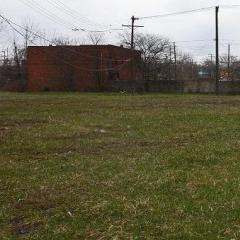How to correctly apply the product manually. How to shorten the dress
Dress - Favorite clothes of many fashionistas. If you purchased your favorite outfit, but his length does not suit you, you can shorten it. In this article we will tell how to strip a dress from different materials.
Load dress from knitwear
Such a tissue is considered the most difficult, since it will not work out the classic seam. After all, when re-stretching, the thread simply breaks. In order to shorten the outfit, a special plays woofer is needed. It processes the product with double seam. If you look from the wrong side, you will see a dense thick line from confused threads. From the front side there are two neat lines. Of course, such a car is far from all. Therefore, you can drip the dress on the usual sewing machine with parallel lines.
How to make an invisible
This can be done in two ways:
- manually;
- with a thin tissue lining.
The first way is suitable if the outfit is sewn from a dense costume. The thickness of the canvas allows paving the thread between the fibers of matter. In order not to be seen marks from punctures, you will need a thin and short needle, as well as a thick lining of a small thickness. You need to process the location of the cut off with overlock and adjust the edge by 5 mm. After that, with the help of a slanting seam, capture a slice and a cloth for 1 cm above it. Try to make a needle between the fibers so that there is no point of punctures. After the whole edge is processed, wean the product.
How to cheer chiffon dress
To do this, you will need a thin lining. It may be a soft knitwear or organza. Make a pattern that in shape should resemble the bottom of the product. Sewing among themselves the bottom of the dress and lining. Remove the place of the seam and run it. Now the upper part of the lining is visiting to the seam on the belt. It is necessary that the lining length is a few millimeters longer than the length of the dress. So the product will not "pull".

Clothes from very thin fabric can be simply treated with overlock. After you get rid of scattering threads, you do not need anything. The more often the seam, the more reliable the mark. In this way, fabrics are treated. This is usually done in casual clothes or Maxi dresses.

Seam "American"
This dresses binder method is used if the outfit is made of translucent tissue. You need to roll the bottom of the roller with a small diameter with a thumb. You should have something like a tube. Now pierce the fabric from the front side to the width of 1-2 threads. The entire tube must be covered by the thread. After work, wean the location of the cut.

Treatment of edge Kobobayika
For the design of the product, use a special braid. This method is ideal for processing the seat of the cutting of costume and monotonous fabrics. You need to sew one edge of a coasty from the wrong side. And from the front edge, pin the ribbon pins. Stop boika, retreating 1 mm from the edge.

If your dress is very expensive, and you do not live with a needle and threads, contact the atelier. There is a dress from any fabric for a little money.
Substitutional entry refers to those operations with which even those who do not like to sew. Of course, tailoring curtains or fitting trousers in growth can be trusted by professionals, but almost every woman had to deal with the problem of the healing hemp or the need to shorten the too long skirt. Make it is quite simple, and possibly having mastered these simple operations, you love to sew yourself.
How to align the bottom?
When it comes to sewing a curtain, then most often the line of the binder is flat. If we are talking about the skirt, especially the broken, then the line of the Niza is aligned directly on the figure, while the belt and the fastener must be well adjacent.
To carry out this operation, they become a flat surface in that shoes with which it is expected to wear this thing. In this case, an assistant with a vertical wooden line, one end of which is placed on the floor, marks the appropriate level across the entire circumference of the hem.
However, this operation can be done independently, if in the doorway, fix the rope at the desired height, densely in chalk (Fig. 1). To the marked line, it is necessary to add an allowance for a bending and seams whose width will depend on the method of processing Niza.
How to independently note the lines of the pent of the skirt
Processing without poda
The easiest way that does not require the use of special techniques is the processing of edge overlock. In some cases, such a line, for example, made by a contrasting thread, looks very attractive (Fig. 2).
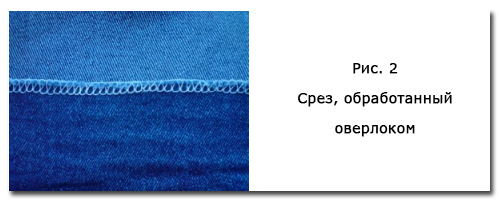
The processing of a slice of a zigzag or roller overlock, in which a neat rutter is formed, well suited for thin tissues (Fig. 3). After processing, sticking tissue threads need to be trimmed. An even more beautiful seam is obtained if the zigzag is laying at some distance from the edge, and then neatly cut off the extra material.
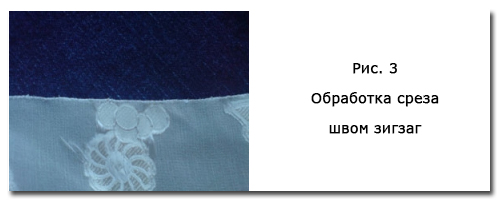
Beautiful and neat stitching is obtained by using oblique bey. For thin tissues, it is admonished in the form of edging. For this, the oblique beyk (better to take ready) is folded in half and affix, then the edge of the fabric is inserted inside the edge (Fig. 4). The same method is well suited for the processing of the inner seams of the bulk material.
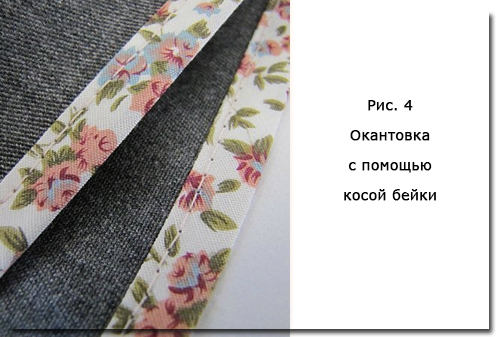
So that it is thus the dense material, it is necessary to need a bending of about 0.5 cm. The fabric and bay are folded by the front sides and paste along the lower edge. Then, the beaks are rejected on the wrong side, they are roaring and paste through its upper edge (Fig. 5). This layer method is well suited when the skirt length is insufficient for a standard pent.
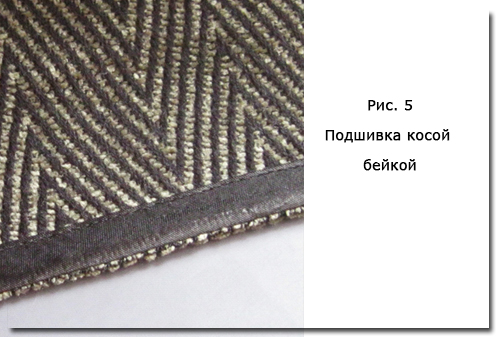
Treatment of the edge
The standard width of the swelling of the skirt is 3-4 cm, for thin tissues, this value may be less. To make a neat subheading line with a straight face, it is convenient to use a sheet of paper with a horizontal line with the desired distance. Bend the edge of the hemp for this distance and endure the iron - you will get a perfectly smooth line, and then the bend is not printed on the front side (Fig. 6).
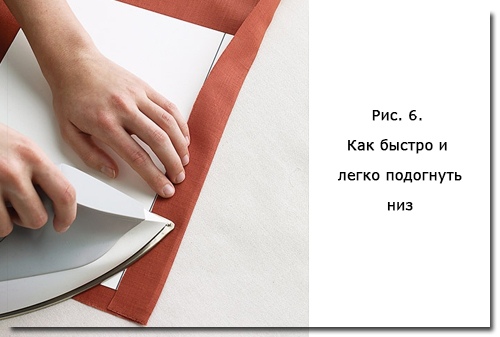
In the folded lines fold, it is much more complicated. To facilitate this operation on the bottom of the product, two parallel lines are parallel (Fig. 7). Then the lower line is a little donate, the fabric is inside out along the top line, pushed the pins and smooth.
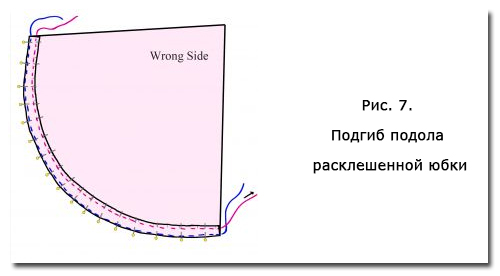
The simplest method of processing the adjacent edge, with which even those who do not know how to sew, is to use adhesive tape. It is embedded in fold and processed by a hot iron (Fig. 8). For heavy textiles, it is recommended to invest two such tapes.
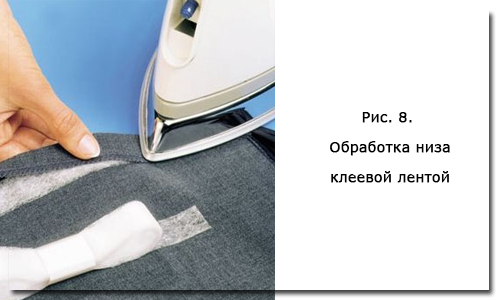
Professional dressmakers do not recommend using in this way of fixing the hem, considering that it makes tissue tougher. In addition, the adhesive tape after washing is likely to be glued again. During our grandmothers for products from costume and fingertips, traditional sedatives (Fig. 9) and a goat (Fig. 10) are used, which to date are performed in an expensive studio.
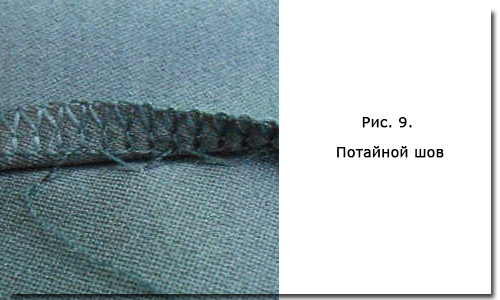
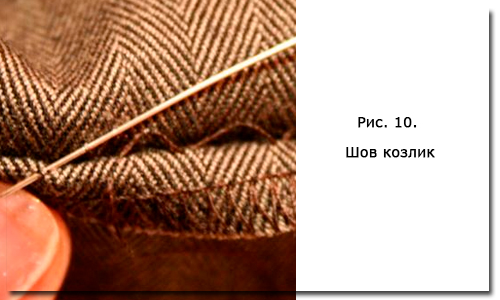
Beautiful execution of such a binder requires a skill and considerable time. With professional clothing manufacture, this operation is most often performed by a secret machine line. A simpler decision is a simple rejection of twice bent edges (Fig. 11), which is well suited for sport style clothes.
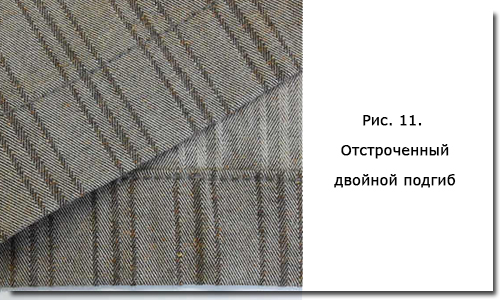
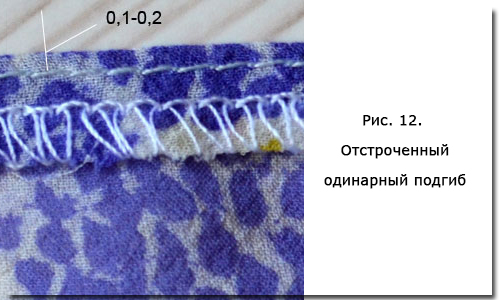
One of the most beautiful, although complex methods of binder subtle materials is the so-called Moscow seam. Its width is about 3 mm, while on the involving side there are 2 lines, and on the facial - one. And they are performed in such a sequence (Fig. 13):
- Leaving with 1 cm with a string point, the bending is made by no more than 4 mm, they are revealed and sting the fold as close as possible to the edge.
- Gently cut the fabric from the edge to the line, leaving for more than 1 mm.
- Once again, we turn the bending to the wrong side so that the line is around in the middle, and stroke it.
- Collect the bending from the inside as close as possible to the first line. Experienced craftsmen make the first handing over with a contrasting thread, and then remove it to get one seam from the face.
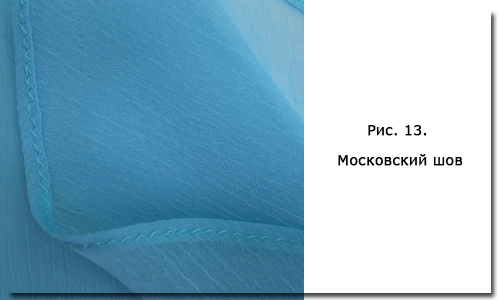
If the dress is too expensive and do not want to trust the shortening of the product to someone, you will have to work with your own hands. Bearing options will depend on what fabric is sewn the product.
A hardware in the processing is considered knitwear, so knitted dress can not be simply suitable for a classic seam. To shorten the dress, a plays woofer is required, processing the hem of dresses by double seam.
But there is no such machine from everyone, so it is possible to use parallel lines performed on a sewing machine to shorten the knitwear.
For products from thin and flowing fabrics, you can use the method of invisible bending. Such seam requires additional costs of time and materials, gives some thickening to the pole, but it is well hidden.
To sunmove this method, you need to take a lining (organza or soft knitted fabric), make the pattern, on the form resembling the bottom of the dress, sew the bottom of the dress and the pattern of the lining among themselves, seam to expand and irip. Next, the top of the lining sew to the seam on the belt product.
It is important to make a lining longer than the product itself (for a couple of millimeters) so that it does not "pull"
But how to apply a dress without a machine: when preventing products from woolen and costume fabrics, a secret seam is used. On such products will not be noticeable with a needle. Sembles this way you need a thin needle in one thread. It should be done right to left, the stitches of about 0.7 cm. The thread should be carried out below the overlock line, then the secret seam will be durable and reliably covered from prying eyes.
Also for products made of dense and woolen tissues, the method of processing the hem with a special braid (nice) can be used. It is only necessary to sew one edge from the wrong side, and on the front side, fixing the candle to the pins, flash it, retreating from the edge of 1 mm.
Here are such ways you can adjust the aid of different dresses. And if you are wondering if you can sort a wedding dress, then do it personally do not advise folk signs. Especially since the wedding dress is a very complex product, so his shorting is better to entrust professional masters in the studio.
Substitutional entry refers to those operations with which even those who do not like to sew. Of course, tailoring curtains or fitting trousers in growth can be trusted by professionals, but almost every woman had to deal with the problem of the healing hemp or the need to shorten the too long skirt. Make it is quite simple, and possibly having mastered these simple operations, you love to sew yourself.
How to align the bottom?
When it comes to sewing a curtain, then most often the line of the binder is flat. If we are talking about the skirt, especially the broken, then the line of the Niza is aligned directly on the figure, while the belt and the fastener must be well adjacent.
To carry out this operation, they become a flat surface in that shoes with which it is expected to wear this thing. In this case, an assistant with a vertical wooden line, one end of which is placed on the floor, marks the appropriate level across the entire circumference of the hem.
However, this operation can be done independently, if in the doorway, fix the rope at the desired height, densely in chalk (Fig. 1). To the marked line, it is necessary to add an allowance for a bending and seams whose width will depend on the method of processing Niza.
How to independently note the lines of the pent of the skirt
Processing without poda
The easiest way that does not require the use of special techniques is the processing of edge overlock. In some cases, such a line, for example, made by a contrasting thread, looks very attractive (Fig. 2).
The processing of a slice of a zigzag or roller overlock, in which a neat rutter is formed, well suited for thin tissues (Fig. 3). After processing, sticking tissue threads need to be trimmed. An even more beautiful seam is obtained if the zigzag is laying at some distance from the edge, and then neatly cut off the extra material.
Beautiful and neat stitching is obtained by using oblique bey. For thin tissues, it is admonished in the form of edging. For this, the oblique beyk (better to take ready) is folded in half and affix, then the edge of the fabric is inserted inside the edge (Fig. 4). The same method is well suited for the processing of the inner seams of the bulk material.
So that it is thus the dense material, it is necessary to need a bending of about 0.5 cm. The fabric and bay are folded by the front sides and paste along the lower edge. Then, the beaks are rejected on the wrong side, they are roaring and paste through its upper edge (Fig. 5). This layer method is well suited when the skirt length is insufficient for a standard pent.
Treatment of the edge
The standard width of the swelling of the skirt is 3-4 cm, for thin tissues, this value may be less. To make a neat subheading line with a straight face, it is convenient to use a sheet of paper with a horizontal line with the desired distance. Bend the edge of the hemp for this distance and endure the iron - you will get a perfectly smooth line, and then the bend is not printed on the front side (Fig. 6).
In the folded lines fold, it is much more complicated. To facilitate this operation on the bottom of the product, two parallel lines are parallel (Fig. 7). Then the lower line is a little donate, the fabric is inside out along the top line, pushed the pins and smooth.
The simplest method of processing the adjacent edge, with which even those who do not know how to sew, is to use adhesive tape. It is embedded in fold and processed by a hot iron (Fig. 8). For heavy textiles, it is recommended to invest two such tapes.
Professional dressmakers do not recommend using in this way of fixing the hem, considering that it makes tissue tougher. In addition, the adhesive tape after washing is likely to be glued again. During our grandmothers for products from costume and fingertips, traditional sedatives (Fig. 9) and a goat (Fig. 10) are used, which to date are performed in an expensive studio.
Beautiful execution of such a binder requires a skill and considerable time. With professional clothing manufacture, this operation is most often performed by a secret machine line. A simpler decision is a simple rejection of twice bent edges (Fig. 11), which is well suited for sport style clothes.
In a narrow step, this line can be performed using a special bump foot. For thin tissue, as well as for the intelligent models, the edge processing is overlock, and then it is 0.21 cm, then it is 0.21 cm above the rejected fold line (Fig. 12). So that the upper edge does not scroll, two parallel lines can be made with a wide pod.
One of the most beautiful, although complex methods of binder subtle materials is the so-called Moscow seam. Its width is about 3 mm, while on the involving side there are 2 lines, and on the facial - one. And they are performed in such a sequence (Fig. 13):
- Leaving with 1 cm with a string point, the bending is made by no more than 4 mm, they are revealed and sting the fold as close as possible to the edge.
- Gently cut the fabric from the edge to the line, leaving for more than 1 mm.
- Once again, we turn the bending to the wrong side so that the line is around in the middle, and stroke it.
- Collect the bending from the inside as close as possible to the first line. Experienced craftsmen make the first handing over with a contrasting thread, and then remove it to get one seam from the face.
Consider in detail the pencil and several other options for processing Niza.
The first thing to do is to measure the skirt and clarify its final length. On the fitting, make a front label at the desired height, we will navigate to it.
Fold the skirt so that the side seams are combined, and the bends turned out to be in the middle of the front and rear side of the skirt.
The skirt pencil is alone on the sides, so when folding on the table, its bottom has a curved view. This is completely normal for a narrowed skirt. The smaller the alignment, the straight line of Niza. For a straight skirt, it is completely even.
Before, how to fade skirt, Draw a line of Niza. Through our label, the line to the side seam. This line must be at an angle of 90 ° to the bending of the front panel skirt (you can check the triangle). Also enter the rear cloth.

These two lines converge at one point on the side seam and form an angle that you need to sharpen smoothly. For this (best of all on the lecture), we will carry out a smooth line just below. We got a snize line skirt.

Now you need to align the allowance for the bending, cut up too much. Normal Skirt Niza Processing - 3-4 cm. At such a distance from the first line below, they do a parallel line - this is a cut line.

On the first line, scroll the skirt with pins to fix two layers of fabric. Now they cut off all over the cut line.

Do not rush to remove the pins - on the reverse side of the skirt they will help copy the line of Niza. We put the labels, draw the line on them.

We continue to process the bottom of the skirt - we take a cut, turn it out inside out exactly our line, we rush the pins. We do it all over the bottom of the skirt.
How to make a double wide bending niza skirt
Another option is - suitable for sports style models - denim skirts, x / b and linen skirts, on which the stop is performed. Bottom skirts with double fog ticking. Bending can be quite wide - up to 8 cm.

The inner bend of such bending can be narrow - 1-1.5 cm or wide, as well as external. So, for the bending 3 cm wide on the finished form of a snake for the treatment of the skirt, we make 6 cm.
Procedure: Blacks on the front side of the skirt line of Niza, start all 6 cm on the wrong side, and now these 6 cm bend in half (cut to the collar) and sometimes affect. It remains to be used the skirt by car. Scatching better from the front side. You can pre-notice.
Nose Nose Nose Processing Skid

If the fabric was saved on the fabric and the allowance turned out to be narrow, there is such an option to process the nose of the skirt - they snapped, they were told to the edge. But all the same, such a treatment is suitable more for thin tissues or models with slices - skirts tailored by oblique, cumulative skirts (sun, half-length), skirts with flocks, frills.
For lung ski skirts, other thin tissues correctly apply the skirt to help the master class. This seam is used for straight and rounded sections of the thinnest tissues.

Moscow Sow.
If the skirt made of light fabric, easy to process and the lower slice of a straight or slightly rounded, then you can perform a narrow double bending. Squeegement on the bending - 2 cm. Twice we add 0.5 -1 cm and string. If the Eyemer is weak, make as in an example with a wide double bending, using an iron.

